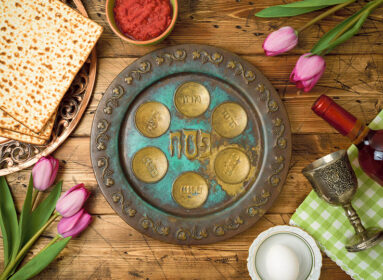
Why doesn’t Joseph’s name appear the Haggadah? The entire Exodus from Egypt can be traced back to the sale of Joseph by his brothers, and Joseph’s subsequent appointment as Viceroy, which paved the way for the 70 descend-ants of Jacob multiplying into a nation that would suffer under the whip of the Egyptian taskmasters.
It’s true that Joseph’s name is not mentioned explicitly in the text, but his presence does hover over the seder’s proceedings. Early sources deal with how Joseph’s life permeates the seder, albeit in a subtle form, and we don’t have to go any further than the karpas right there on the seder plate.
The Sages who link the word karpas to the story of Joseph.
Rashi does it linguistically. In his commentary on the verse in which Joseph’s coat of many colors is mentioned (k’tonet Pasim in Gen. 37:31), Rashi writes that the word passim, “…denotes a cloak of fine wool…” and he goes on to quote a verse from Megillat Esther in which the text describes the wealthy and rich embroidery of King Ahashveraus’ palace: “There were hangings of white, fine cotton (Karpas)…” (Esther 1:6) Note the presence of ‘pas’ in both words.
What Rashi did linguistically, Rabenu Menoah (of Narbonne, late 13th century) in his commentary on certain sections of Mishne Torah (Laws of Chametz and Matzah, CH. 12, Hal. 8) expresses directly by explaining that the karpas we take at the beginning of the seder, “recalls for us the coat of many colors, which Jacob our Father made for Joseph and which was the crucial factor in the Jews’ enslavement in Egypt.” This idea is also discussed by Rabbi Solomon Kluger, (1785fi1869) in Yeriot Shlomo, his commentary on the Haggadah as well as other special prayers, that the only reason we ever got to Egypt was the result of Joseph being sold by his brothers.
But the connection between Joseph and aspects of the Passover seder is already hinted at in the Talmud. After the lamb was sacrificed in the Holy Temple, it was then brought to the place where it was going to be eaten. A Braita at the end of the fifth chapter of B.T. Pesachim discusses how the animal was slung over one’s shoulder in its skin. To this discussion, R. Ilish adds one word, “Tayot,” (B.T. Pesachim 65b) which Rashi explains is a reference to the manner in which Ishmaelite traders transport animals.
Although we know very little today about their techniques, R. Ilish’s additional comment (as interpreted by Rashi) steers our mind back to another group of Ishmaelite traders who appeared on the horizon at a crucial moment in Joseph’s life, providing Judah with the opportunity to declare: “What profit is it if we slay our brother and conceal his blood. Come let us sell him to the Ishmaelites…” (Gen. 37:26-27) without the Ishmaelites, Joseph would have never ended up in Egypt.
The connection between the Haggadah to the Joseph story is also evident in the charoset, featured on the seder plate. According to the Yerushalmi, the blend of apples, date and wine into which we dip the maror (bitter herb) symbolizes the heinous act of the brothers when they dipped Joseph’s coat – the k’tonet passim – into goat’s blood, compounding their evil by allowing their father to believe that Joseph had been devoured by a wild beast.
The Joseph story involved two areas of mishaps. The first was the havoc that resulted from Jacob favoring Joseph over the other brothers (Gen. 37:31). The sibling rivalry divided the house of Jacob-Israel and resulted in our lack of unity today.
But on this night of the seder, every father is given the opportunity to begin to turn things around. With the entire family gathered around the table, the Pesach Haggadah allows the father to achieve a desired equality and love between the children. The children are all lovingly included in the seder, including the wicked child. We, the parents, have a chance to look at our children around the table and finally give each one the love that he or she needs and deserves! On the night of the seder every parent becomes a teacher, and on this night every father has to remember Jacob’s mistake. As the Talmud declares, it’s forbidden for a father to single out one child over the others, citing Jacob as an example (B.T. Shabbat 10b).
The seder not only looks backwards but it looks forward as well. Parents have to be sensitive to sibling rivalry, finding ways to acknowledge the uniqueness of each child. If we succeed on this level, implanting family structures which are loving and sharing and protective and caring, then the ground is being paved for the coming of the next redemption.
Rabbi Shlomo Riskin is chancellor of Ohr Torah Stone and chief rabbi of Efrat, Israel.








 Southern New England Jewish Ledger
Southern New England Jewish Ledger








